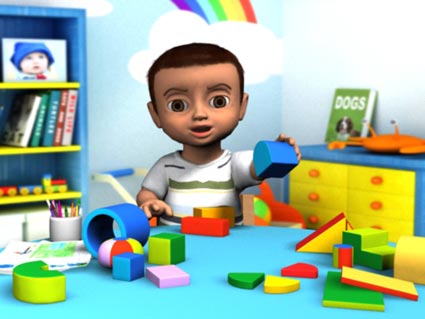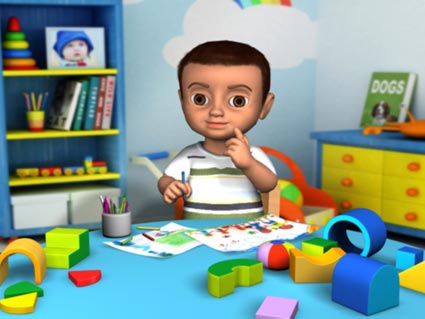Interview with Michelle Burnett, Ph.D., CCC-SLP, Cleveland Hearing & Speech Center
Linda Schreiber: I'm interviewing Michelle Burnett, who is with the Cleveland Hearing and Speech Center. I was amazed to learn about a parent education effort available at the Center's website called Baby Lingo. Hello, Michelle. Thanks for joining me this afternoon.Michelle Burnett:Hello.Linda:Miche
 Linda Schreiber: I'm interviewing Michelle Burnett, who is with the Cleveland Hearing and Speech Center. I was amazed to learn about a parent education effort available at the Center's website called Baby Lingo. Hello, Michelle. Thanks for joining me this afternoon.
Linda Schreiber: I'm interviewing Michelle Burnett, who is with the Cleveland Hearing and Speech Center. I was amazed to learn about a parent education effort available at the Center's website called Baby Lingo. Hello, Michelle. Thanks for joining me this afternoon.Michelle Burnett:Hello.
Linda:Michelle, would you tell our readers a little bit about your background?
Michelle:I completed my master's degree in 1990 at Michigan State University and prior to getting into the field of speech-language pathology, I was a business major. So, I've now found a position where I blend two professions; I have the opportunity to be involved in the business aspect of speech-language pathology as well as the clinical aspect at the Cleveland Hearing and Speech Center. At the Center, I manage and oversee the clinical services, which includes speech-language pathology, audiology, and the regional infant hearing program.

Linda:The business/speech-language pathology combination is unique; it sounds like a good match for you.
Linda:Michelle, I spent time at the Cleveland Hearing and Speech Center website and was pleasantly surprised at what I saw. Tell our readers about Baby Lingo.
Michelle:Baby Lingo is an animated child who demonstrates expected speech, language, and hearing behaviors at six months, one year, two years, three years, four years, and five years of age. The idea behind Baby Lingo was to give the viewer a way to actually see what a child at each of these ages would be doing if he or she were generally on track for attaining the usual developmental milestones.

We thought that this might be more illustrative than just having a checklistalthough we also have the checklist on the website and the viewer can click on it to review the list of communication skills a baby at a certain age might have. Through the animation we try to depict as much of the behavior as we can in a cohesive, quick skit that was scripted specifically to include key milestones.
Linda:The animations look so realand so dimensional.
Michelle:We were really happy with the way the artist created it. The artist, Jessie Ng, had just graduated from the Cleveland Institute of Art when she started this project. Despite availability of some sophisticated software, Jessie animated the movements by hand to ensure a more realistic, smooth movement. Some of the research behind animation shows that even with adults, people are more engaged and more attentive to an animated character than to a filmed child or parent-child interaction. We hope that is true, and that for those who watch it, it keeps their attention.
Linda:I have no doubt what you have created will hold the viewer's attention. Michelle, who do you hope your viewers are?
Michelle:We had more than one audience in mind because our center serves so many different people. We clearly hope that it's helpful to parents. Either parents who are wondering "What should I expect next out of my child?" and "When should I see this happening?" or parents who have some specific concerns about what they're seeing their children do or not do. These parents can go to the website and see the behaviors in action and also read about them and get more information.
We also think it's going to be useful to educatorslike those teaching speech and language development courses in university communication science and disorders programs, and those educators in fields of child psychology or child development. We think it has a great application for parent education and training for other SLPs too.
Linda:So if I were working with a young child with special needs, I could access the website with the child's parents and use the animations in an instructive way?
Michelle:Yes, the parent can begin to start drawing some conclusions about where his or her child is at and what's appropriate to expect.
Linda:Will you include demonstrations of how to develop a child's language?
Michelle:In part we're working on that now. When you're on the website, and you view Baby Lingo at a certain stage, you can scroll down a little bit to find a listing of the developmental milestones for that particular age range. That list can be used as a checklist. We're hoping to add a feature that would include activities to do with your child at a particular age or strategies that facilitate the development of communication skills. Some of that content has recently been developed and we hope to add it to the website early next year.

Linda:I'm curious about your purpose in using this type of media.
Michelle:Baby Lingo evolved out of an original goal, which was to create a more interactive, informative website. We were originally granted funds to revamp our website, and we wanted it to improve it in several ways. We wanted it to be educational and informative, but also user friendly and interactive. Our work with Dr. Stacy Williamswho was a professor at Case Western Reserve University at the timeon another project regarding the use of virtual reality and animation helped as we conceptualized Baby Lingo.
Linda:Animation is not inexpensive. You mentioned you had funding for this project.
Michelle:A grant from the AT&T Excelerator program funded almost 80% of the cost of the website with the remaining amount coming from The Elizabeth Ring Mather and William Gwinn Mather Fund, which is a local family foundation in Cleveland. Together those grants allowed us to completely redesign our website. Additional partners on the project included Great Lakes Publishing, who created the overall website design and completed the programming; Case Western Reserve University; and the Cleveland Institute of Art. Everyone participated in the development of the animations and interactive segments, including Baby Lingo.
Linda:And the website is accessible to anyone without fee or subscription?
Michelle:There is no fee. Our mission includes community education to promote an understanding of the importance of communication. We thought being able to access information and interact with it to learn would be one way of reaching out to the community to fulfill this part of our mission.
Linda:And do you have plans for more animations?
Michelle:We're looking forward to adding more animation and interactivity as well as some items that viewers could download for use in the home. We're planning to provide additional content that parents can access. For example, if parents clicked on Baby Lingo at age 3, we want them to not only watch the animation, but also be able to download activities that are appropriate to do with their child.
Linda:Michelle, Baby Lingo is truly amazing. Readers can access Baby Lingo on the home page of the Cleveland Hearing and Speech Center: www.clevelandhearingandspeech.org
or you can directly access Baby Lingo at: www.chsc.org/Baby_Lingo
Linda:Thanks for the interview today Michellewe are looking forward to seeing your library of Baby Lingo animations grow.
